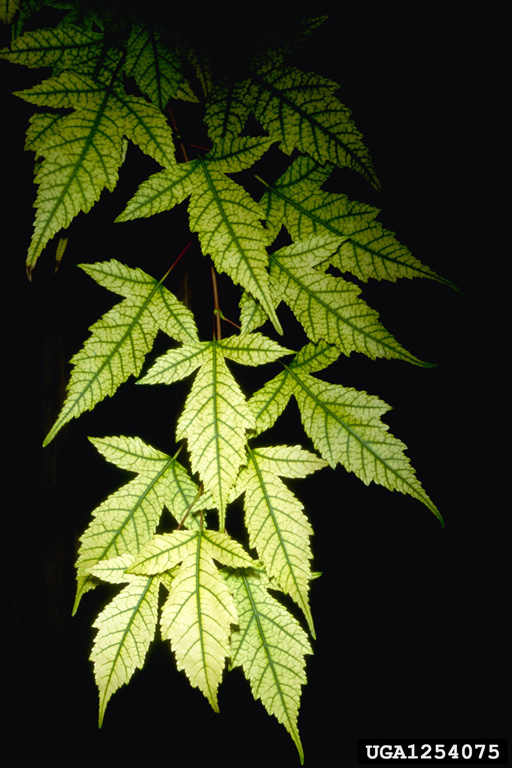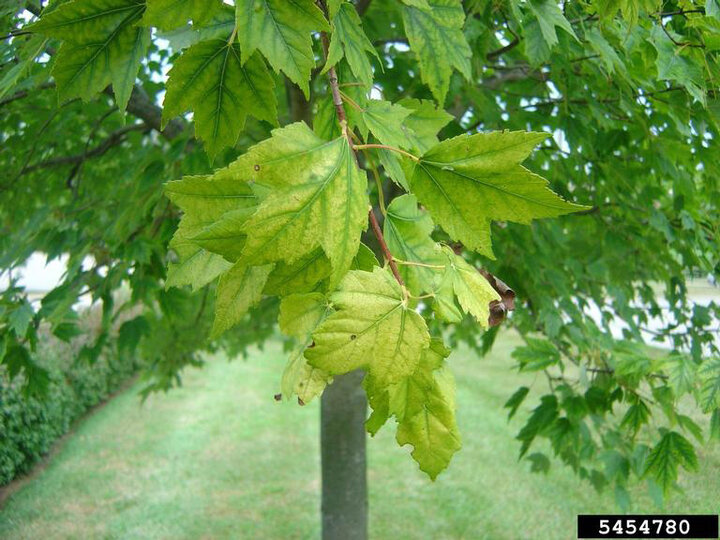Sarah Browning, Nebraska Extension Educator

Iron chlorosis on foliage of trident maple. Image by William M. Ciesla, Forest Health Management International, Bugwood.org
Eastern Nebraska tends to have high soil pH, also known as alkaline soil, which can cause problems for some plants, like river birch, pin oak, big-leaf hydrangeas and blueberries to name a few. Alkaline soil changes the availability of certain plant nutrients, often making them less available, resulting in deficiency symptoms.
Other conditions contributing to the chlorosis include the following.
- Wet compacted soil with poor oxygen penetration.
- Root damage reducing a tree’s ability to pull up existing nutrients. Roots buried too deeply in the soil also don’t function at peak efficiency and can contribution to chlorosis.
- High nitrogen or phosphorus levels in the soil can bind-up the available iron, preventing it from being available for tree roots to absorb.

Chlorosis Symptoms
Chlorosis is characterized by light green or yellow leaves with darker green veins. As the deficiency worsens, leaves become scorched and brown around the edges or between the leaf veins. Severe deficiency can cause branch dieback and, if left untreated, cause death of the tree over the course of several years.
Iron is the most commonly deficient nutrient, but the same symptoms can be caused by manganese deficiency, too. Leaf tissue and soil testing is the only way to accurately determine which is the cause. For this reason, some chlorosis products used by arborists contain both iron and manganese.

Chlorosis Treatments
There are several methods for treating chlorosis, each with its own advantages and disadvantages.
Broadcast sulfur applications to the soil – intended to lower the soil pH and convert the existing natural iron to a form more easily absorbed by tree roots.
- Advantages – relatively inexpensive and can be done by homeowners with a fertilizer spreader.
- Disadvantages - changing soil pH is difficult and happens slowly.
Iron chelate application to the soil – chelated forms of iron are more easily absorbed by tree roots. Look for products like Fertilome Chelated Iron EDDHA 6%. These products are water soluble, dissolved in water and poured around the base of the tree.
- Advantages - can be effective and are easy to apply.
- Disadvantages – expensive and have a short-term effect, usually only one year.
Trunk injections or implants – these products place iron directly into a tree’s trunk via holes drilled in the root flare.
- Advantage – highly effective at treating chlorosis for 1 to 3 years.
- Disadvantage – causes physical damage to the tree each time it is treated. Injections should only be done by certified arborists trained in the procedure.
Whitcomb Method – a grid of holes are drilled in the soil beneath the tree’s canopy and filled with three products - sulfur, a complete fertilizer and a micronutrient fertilizer.
- Advantages – can be very effective and provide long-term chlorosis control.
- Disadvantage – the initial treatment is labor intensive. It can also be difficult to find the required micronutrient product.
Iron nails, shavings or other forms of solid iron buried in the soil are not effective at treating chlorosis in alkaline soil. As the iron breaks down, it is tied up by the soil chemistry just as the naturally occurring iron is.
If trees in your landscape have a history of chlorosis, now is a great time to develop a treatment plan for this growing season.
For more information on treatment options for chlorosis.
- Chlorosis of Trees in Eastern Nebraska, Nebraska Forest Service
- Chlorosis of Trees in Central and Western Nebraska, Nebraska Forest Service
Reference to commercial products is made with the understanding that no discrimination is intended and no endorsement by Nebraska Extension is implied. Mention does not imply approval or constitute endorsement by NebraskaExtension. Nor does it imply discrimination against other similar products.
Images
- Chlorosis symptoms in red maple. Image by Jason Sharman, Vitalitree, Bugwood.org.
- Chlorosis in pin oak. Image by Joseph O'Brien, USDA Forest Service, Bugwood.org.
Search Our Archive
Associated Video
Chlorosis
Lime green foliage could mean your trees or shrubs have chlorosis. UNL Director of Landscape Services Jeff Culbertson talks about what causes chlorosis and what you can do about it.